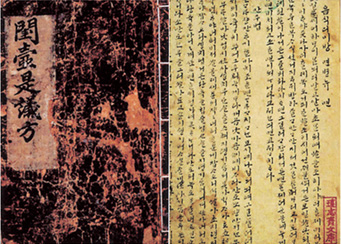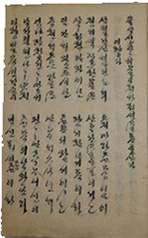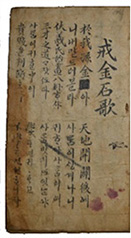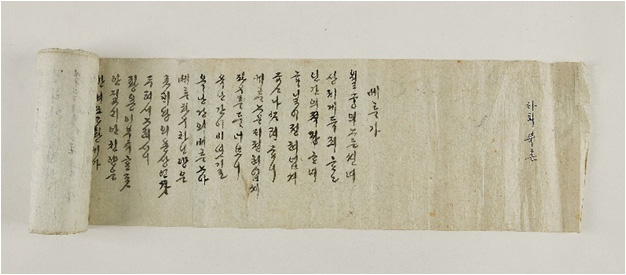Overview
Artistic value of Hangeul calligraphy and scroll
Naebang-gasa is an important data where one can encounter the unique fonts of traditional women. In Joseon Dynasty women were able to become the subjects of enjoyment of letters through Hangeul and created unique styles and fonts. This is the style of writing used in Hangeul letters and Umsikdimibang, and Gungseo font used by women in the palace. The creation and transcription of the lyrics were also one of the main activities of enjoyment of the letter. In particular, it should be noted that the main motivation of women's transcripts was to receive fonts.
 <Umsikdimibang> ⓒYeongyang-gun Office
The manuscript of the existing Naebang-gasa contains the unique fonts of women. Through this, one can directly see the aesthetic characteristics and value of letters. Letters have great value as a means of expressing knowledge or emotions, but the aesthetic value of forms of letters is also great. The act of writing and copying lyrics was another aesthetic experience for the enjoyers of Naebang-gasa.
<Umsikdimibang> ⓒYeongyang-gun Office
The manuscript of the existing Naebang-gasa contains the unique fonts of women. Through this, one can directly see the aesthetic characteristics and value of letters. Letters have great value as a means of expressing knowledge or emotions, but the aesthetic value of forms of letters is also great. The act of writing and copying lyrics was another aesthetic experience for the enjoyers of Naebang-gasa.
Nowhere in the world have women created their own fonts, polished their aesthetics, and have recorded their attachment to letters. In this respect, the global significance and independence of Naebang-gasa should be further emphasized.
 Regular script
Regular script
<Nyeokdae-ga>
 Regular script
Regular script
<Dosan Yukgok>
 Cursive script
Cursive script
<Ihyangga>
 Cursive script
Cursive script
<Gyegeumseok-ga>

Nowhere in the world have women created their own fonts, polished their aesthetics, and have recorded their attachment to letters. In this respect, the global significance and independence of Naebang-gasa should be further emphasized.

<Nyeokdae-ga>

<Dosan Yukgok>

<Ihyangga>

<Gyegeumseok-ga>
On the other hand, the formal value of the scrolls of housewives is also important. Scrolls of intellectual work in human cultural history have great value. Before scrolls, there one could engrave letters on stones, pottery, and wood. However, it is common theory that the public circulation of thoughts did not begin until the advent of scrolls. Scrolls have existed in China under the name of white paper since the Advanced era. This was a book written on something like silk, which was rolled up in long scrolls. Scrolls are easy to carry and store. When it is rolled and stored, the surface does not directly contact the air, which prevents oxidation of the surface and has the advantage of good preservation.
 <Beteulga>
However, the value of the scroll does not stop at this practical level. Its aesthetic qualities must also be reexamined. In the Case of Gyenyeoga of Naebang-gasa, the parents or grandmothers of the women getting married put scrolls of conduct regulations in their belongings. Women opened the scrolls to read the lyrics when they were alone, with close colleagues or with friends. At this time, the process of reading a scroll was not just about the delivery of norms or the distribution of knowledge. It was an act of relieving longing and internally possessing again the longing that was relieved. All of this was remembered as an aesthetic experience of emotion.
<Beteulga>
However, the value of the scroll does not stop at this practical level. Its aesthetic qualities must also be reexamined. In the Case of Gyenyeoga of Naebang-gasa, the parents or grandmothers of the women getting married put scrolls of conduct regulations in their belongings. Women opened the scrolls to read the lyrics when they were alone, with close colleagues or with friends. At this time, the process of reading a scroll was not just about the delivery of norms or the distribution of knowledge. It was an act of relieving longing and internally possessing again the longing that was relieved. All of this was remembered as an aesthetic experience of emotion.
However, the preservation is not permanent because the scrolls in the form of Naebang-gasa are based on the fragile hanji. Moreover, with the advent of Codex —a modern form of book— in world human cultural history, scroll-like records are hard to find. In this respect, the preservation of scrolls with existing Naebang-gasa recorded is even more important.

However, the preservation is not permanent because the scrolls in the form of Naebang-gasa are based on the fragile hanji. Moreover, with the advent of Codex —a modern form of book— in world human cultural history, scroll-like records are hard to find. In this respect, the preservation of scrolls with existing Naebang-gasa recorded is even more important.


